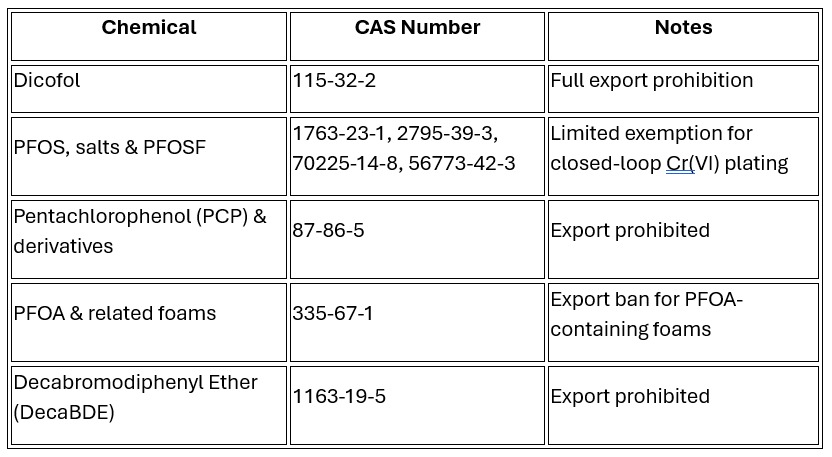The European Union has strengthened Regulation (EU) No. 649/2012 (PIC Regulation) by expanding export bans and tightening consent requirements for hazardous chemicals. These updates align with the Rotterdam Convention and EU POPs rules, reinforcing responsible global chemical trade.
Key Regulatory Updates
Substances Added to Annex I:
• 48 substances newly listed:
o 35 pesticides banned under Plant Protection Products Regulation (PPPR)
o 1 substance non-approved under Biocidal Products Regulation (BPR)
o 6 industrial chemicals restricted under REACH
o 2 substances added under the POPs Regulation
Substances Removed from Annex I:
• Maleic Hydrazide and salts (approval renewed)
• Octabromodiphenyl Ether (OctaBDE) consolidated under new entry
• Dicofol (export now banned under Annex V)
New Export Bans — Annex V Part 1

|
Additional updates include stricter limits for recycled brominated diphenyl ethers and the formal addition of DecaBDE under POPs.
Mercury Restrictions — Annex V Part 2
Major additions include mercury compounds and mercury-added products:
• Mercury chemicals (e.g., Mercury(II) sulphate, Mercury(II) nitrate)
• Mercury-containing lamps (CFLs, linear fluorescent, HP mercury lamps)
• Batteries/accumulators (>0.0005% mercury)
• Switches & relays (with certain exemptions)
• Cosmetics, pesticides, antiseptics containing mercury
Exemptions exist for museum items, high-precision scientific devices, and legacy equipment.
Compliance Requirements
Exporters must now:
• Check products against updated Annex I & V lists
• File notifications via the ePIC system
• Obtain importing-country consent before export
• Prepare for extended clearance timelines and documentation reviews
Industry Impact
These updates significantly affect exporters of:
• PFAS chemicals
• Persistent flame retardants
• Mercury-containing products
• Industrial and agricultural chemicals
Sectors such as manufacturing, waste management, specialty chemistry, and environmental services will face increased compliance obligations and potential supply chain impacts.
Reference: EU PIC Regulation Update 2025
Reach out to our regulation experts on chemical and product regulatory compliances



